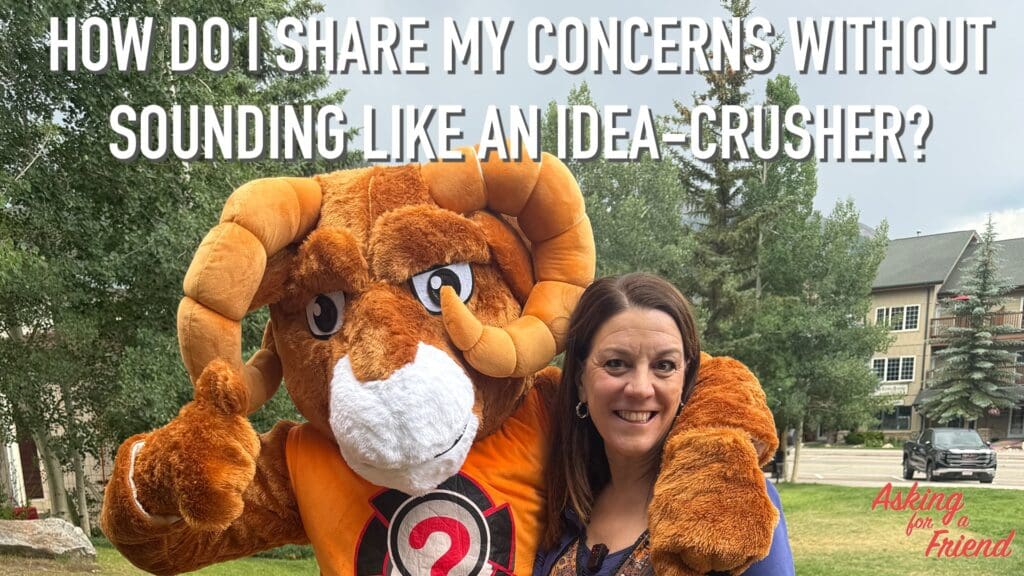To get better executive leadership support, ask for what you need.
You have lots of great reasons to want better leadership support for your team.
An executive visit can really help provide strategic context and reinforce important priorities. A regular cadence of executive exposure opens doors for your high-potential employees. And of course, if your executive is closer to the day-to-day challenges you face, they’re better positioned to share, solicit and respond to ideas and remove roadblocks.
But what do you do if your senior leader is not showing up as often or as supportive as you would like? How do you ask for the leadership support you need without looking needy?
This “Asking for a Friend” question came in through our Let’s Grow Leaders Learning Lab during one of our recent leadership programs.
“I’m finding that my part of the company (team and peers) isn’t getting enough executive-level attention. Is it appropriate to ask for this senior leadership support directly? How do you recommend handling a situation like this? I don’t want to escalate a problem, just to ask for the creativity and support that seems to boost results for other teams by sending a signal about priorities. #Asking for a Friend”
3 Ways to Get Better Executive Leadership Support
If you’re looking for more executive leadership support, ask for what you need, be easy to help, and follow-through.
1. Ask for exactly what you need.
Just like you, your executive leader is doing the very best they can. And, they’ve got more to accomplish in any given day than they could ever pull off.
So, saying something like “I wish you were around more,” is probably not going to get you the support you are looking for.
Start by being really clear about what you need in terms of leadership support.
For example:
- I could really use your leadership support in reinforcing how important this strategic initiative is to the business. Can you please come and share your thoughts as part of my 5×5 communication plan?
- The team has been working so hard, can you please come and thank them and tell them the impact their hard work has made?
- My team has some fantastic ideas about ______ that I think you should hear.
- We’ve really been having a hard time building the strategic partnership we need with this (supplier, client, department). Could you come to our next meeting and reinforce how important they are to us?
- I have an “A player” who I think might be looking around at other options. Can you help reinforce how valuable she is and give her some additional perspective on her long-term career options here?”
- My team and I are having a strategic planning meeting, and I would love for you to join us for the last hour for us to share where we landed and see what insights you may have.”
2. Be easy to help.
Assume that that executive you are looking to engage has a lot on their heart and mind. The easier you are to help, the more helpful their leadership support is likely to be.
For example:
- Here’s how I’ve been communicating this key initiative and why it matters.
- Here’s a list of five people I would love for you to talk with while you are here (and here’s a briefing on what they’ve been doing and why it’s so important).
- The reason I’ve asked my team for ideas about this is _____.
- As you prepare for this meeting with this new supplier, here’s a list of who will be in the meeting and a bit about their background with our company.
- Where we’re really hitting a roadblock with this client is _______. I would love to hear your ideas and perspectives on what we might do next.
- Devon has been looking around at other options. Here’s why he’s a rock star and where I see his future potential.
- We’re going to be working on this MIT (most important thing) in our strategy session. I’d love for you to come up with your ideas on that.
3. Follow through.
In my corporate executive roles, I was always impressed with when my team followed up my leadership support, by recapping the next steps. Executives are human too 😉 Just like you, they care about making an impact.
For example:
- Our visit really made an impact. People seem to really get that this is really important now. Thanks for sharing that story.
- Thanks for recognizing John, he was really grateful for the conversation and is working on that challenge you gave him. He’d love to follow up with you in the next few weeks to share his ideas.
- That meeting with our strategic supplier worked so well. Thank you. Here’s what they’ve committed to as a result.
- Wow, your insights on our strategy were really helpful. As a result, we’ve made the following changes:
- My team loved having you here because _________. We have an End of Year Meeting in December, do you think you could come back again then so we can share what we’ve accomplished?
Being an advocate for your team often means drawing in the leadership support you need. If you want more leadership support, ask for what you need, be easy to help, and follow-through. Your team gets the recognition they deserve, you show up as an organized rock star who cares deeply about your team, and you get the support you need.
Related Articles:
Communicating With Executives When Your World is On Fire
Executive Presence is a Virtual World: What Matters Now
Presenting to Executives: How to Have More Confidence
Share Your Ideas: Practical Ways to Ensure Your Voice is Heard








0 Comments